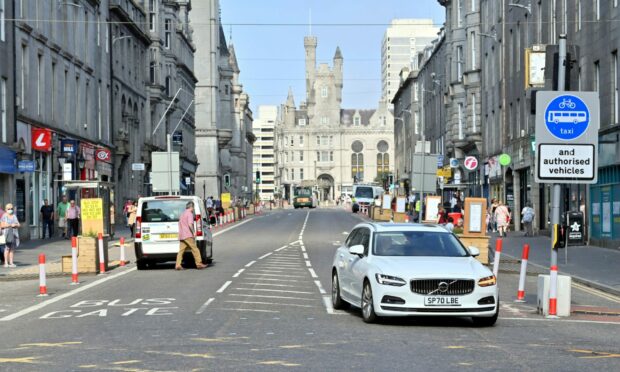Sir, — When researching how to appeal a fine for going through a bus gate on Union Street, I found an article by Emma Morrice: 757 drivers fined for “ignoring” bus gate.
Even the headline assumes culpability on the part of the drivers, who now number in thousands, many of whom I assume are your readers. I did not ignore the bus gate. I was only aware of it at the point where I had to go through it or do a U-turn. I have also returned as a pedestrian and taken photos of the completely inadequate and contradicting signage. If it is confusing to a pedestrian, a driver who has to make split-second decisions to drive safely has no chance.
I believe the P&J could find a bigger and more balanced story if it had sought feedback from those fined. There are several threads on Facebook. Sadly most people pay as there is a discount if you admit you were at fault. I can’t in all honesty do that. If drivers were truly deliberately flouting the restriction, it would follow that there would be a similar scale of fines on the King Street bus lanes (which are clearly marked and where drivers are given time to react).
I would like the question to be addressed — does the council really want drivers to stop driving through the gate, given the lucrative revenue stream, and if they do, have they asked themselves why so many people are “ignoring” this lane and not others elsewhere in the city? I have been fined in the past for accidentally using a bus lane at the wrong time — I accepted responsibility — but this leaves a bitter taste.
Kris Orskov.
Who is arrogant and bumbling?
Sir, — George Emslie (Letters, January 28) seems very angry and maybe a bit worried about Scotland’s journey towards the reality and normality of self-governance.
He may have missed the news from the UK over the last couple of years, but a straw poll conducted today in my kitchen and living room showed a different story to his.
When presented with his pejorative adjectives, nine out 10 Scots thought that “arrogant, bungling, tyranny and power mad” described the Westminster government, not the Scottish Government.
Time for a wee lie-down and a reality check maybe?
Peter E. Smith, Aigas, Beauly.
Wind decision shows disdain
Sir, — It was with dismay that I read of the Scottish Government decision this week to approve the Strathrory wind farm near Alness, and in doing so overturn the Highland Council decision not to approve it (Press and Journal, January 27).
This is a disgraceful act by the Scottish Government on two counts, for it undermines a fundamental tenet of local government, and is a shocking display of arrogance and disdain towards the people of the Highlands. This is yet another example of the Scottish Government riding roughshod over the Highland Council and the wishes of many people in Caithness and Sutherland.
This action by the Scottish Government proves that its draft Onshore Wind Policy Statement — which includes the following statement: “the Scottish Government’s view that onshore wind development should be compatible with the interests and protection of Scotland’s environment and residents” — is not worth the paper it is written on.
One only has to look at the wind farm map of the Highlands to see that there is a massive concentration of wind farms in the Sutherland and Caithness area. Yet those responsible in the Scottish Government continue to be blind to this and seem to have no strategic overview.
What makes this decision especially difficult to understand is that the UK is already unable to use all of the wind energy it produces and is having to make constraint payments to the energy companies when they are NOT generating power. For the Highland area alone, this figure already exceeds £262 million — which the public pay through taxes and their energy bills.
By this action, the Scottish Government, rather than easing the financial burden on hard-pressed families, have caused this burden to increase.
Graham Bruce, Culrain, Sutherland.
